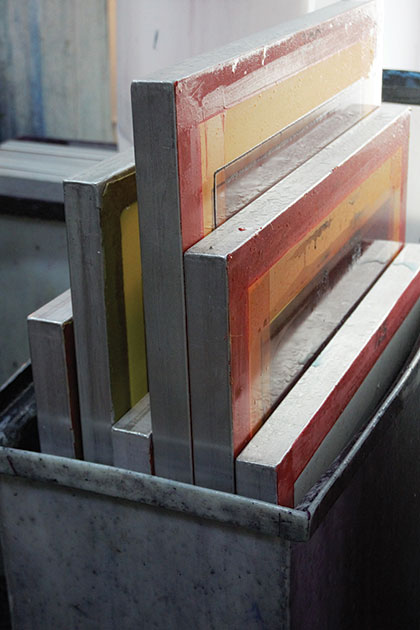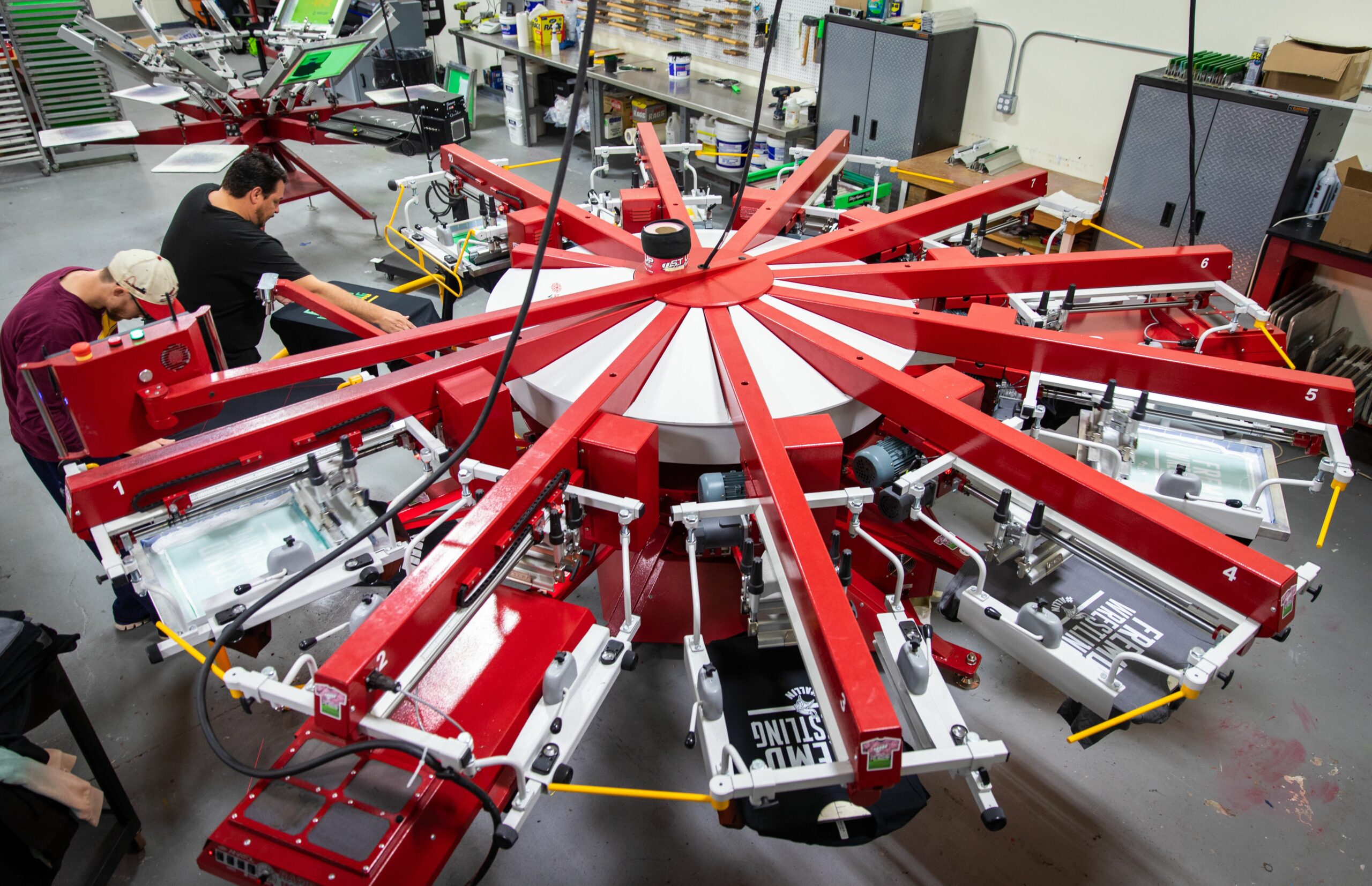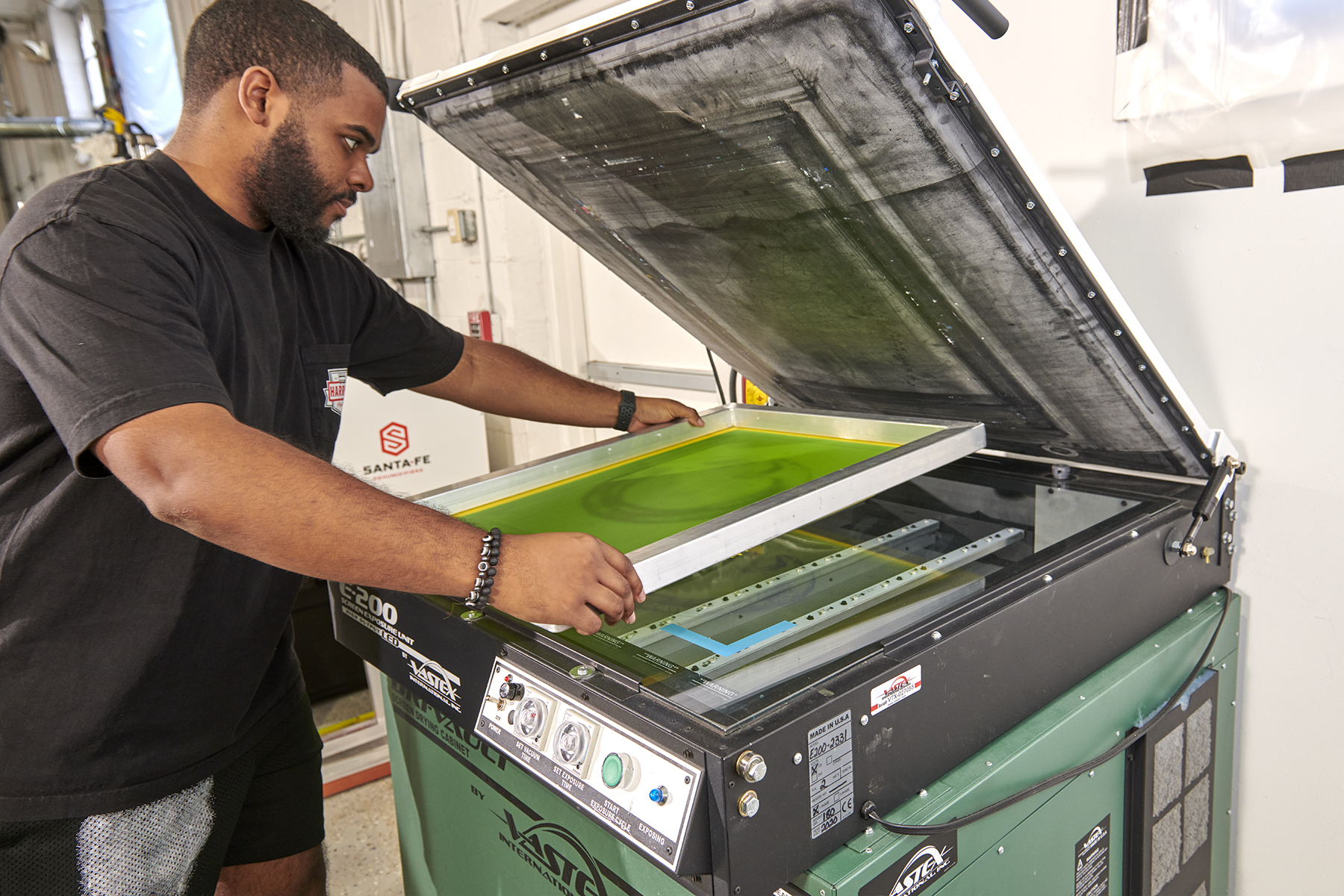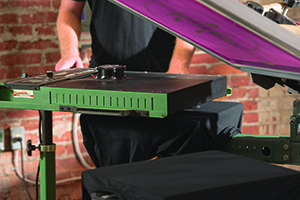August 28, 2018
An often misunderstood and underutilized area of your shop could be the screen room. It sounds obvious, but well-crafted screens are a critical part of the screen-printing process. Yet, shops continue to skimp on best practices, quality employees and equipment for this important department.
In some shops, working in the screen room is considered a punishment of sorts. Reclaiming screens has to be one of the dirtiest and unenjoyable roles in any shop. But when the employees that are tasked to accomplish this chore don’t recognize its importance, is it any wonder why so many shops experience screen-related issues.
Quality screens are the keystone to running an effective shop. To that end, your best employees should undertake that task. Disciplined, craftsmanship-minded problem solvers are ideal candidates for running a screen room.
So if you have screen-room problems, the solutions start with your crew. They need training and support; empathy and respect go a long way, too. You probably publicly recognize your best printer or salesperson during a company meeting, but when was the last time you elevated your screen-room staff to key-employee status? Think about that as you consider revamping your thinking for this essential part of your business.
Best Practices
Besides great people, if you want to make an impact on screen-room workflow, establish shop standards for every step along the way in this area. This means dialing in your shop’s way of completing each step.
Write down the recipe for how each stage of the screen-room work is completed. This holds your team accountable and sets the stage for repeatability. Don’t settle for oral instruction. Ideally, your screen room is operating from a script that is chosen in advance with careful consideration and practice.
For example, the products needed to fill the dip tank should be mixed in an empty five-gallon bucket and then poured into the tank. This keeps the product at the correct consistency, rather than adding the product to the tank and then filling it up with water. The goal is to eliminate variables and this type of thinking controls that process.
Similarly, how can you use that control-the-variables idea throughout your screen-room process? This could include how you fill up the scoop coater with emulsion; the settings chosen for the automatic coater; or when and how screen tension is measured. For every aspect of the screen room, jot down how your shop should be solving any challenges presented.
Managing What You Measure
Measuring is a crucial step to understanding screen quality. In your shop, you should be measuring a few things.
1. Daily Output: How many screens per day are you reclaiming, coating, imaging, exposing and rinsing? You want real numbers, not a “gut feeling.” Collecting this data helps you understand the work that is needed.
Let’s say that your shop averages 50 per day for all five of these steps. What happens if orders on the schedule dictate that around 75 screens per day are needed for the next few weeks? Typically, this is where shops get into trouble if they aren’t proactive in forecasting needs.
The impact on production will be intense. One of the easiest ways to get behind on the production schedule is not having screens available when they are needed. Keep track of your screen room’s daily output and ensure it aligns with your production needs. You can solve a lot of problems early with this step.
2. Screen Tension: You would be shocked at how many shops don’t understand how screen tension, print quality and efficiency are related. Regardless of whether you use panel, static or retensionable frames, the importance of screen tension can’t be overstated. Higher tension will produce a better print with less effort than a screen with lower tension.
A good number of on-press problems could be solved by comprehending the importance of screen tension. For example, if you have to double-stroke a screen for better opacity, or heat press a print after production to smooth out the image, you don’t have a good handle on this situation. Spend some time learning this craft.
As a rule of thumb, don’t use screens with tensions less than 18 N/cm. Tensions between 18 N/cm and 20 N/cm are suitable for one-color images, and anything greater than 20 N/cm will work for multicolor jobs. Screens that are within a tension range of 2 N/cm of each other for a multicolor job will result in easier registration. These are basic rules that should be set for your shop.
For increased quality, consider tension rules for each mesh count. For example, 110 mesh should be tensioned between 25 N/cm and 30 N/cm; 230 mesh should be between 22 N/cm and 24 N/cm; and 305 mesh should be between 25 N/cm and 28 N/cm.
After reclaiming and when the screens are dry, measure the tension with a tension meter. Write the tension number and date in the lower left-hand corner of the screen and cover it with clear packing tape.
3. Other Metrics: Since emulsion is about 60% water, the screen room’s humidity level can have a tremendous impact on screen-drying times. Depending on where you live, weather can greatly affects the workflow in screen room.
Install a hygrometer to measure the relative humidity in this workspace. When you add newly coated screens, you may see a spike in the room’s humidity. If you have a challenge with this, a dehumidifier can remove the air’s moisture content, allowing screens to dry much faster.
You also may want to count the different screen meshes your shop uses. How many of each mesh count are imaged daily? Break that down into average percentages to figure out how many of each screen type to reclaim and coat daily.
Prioritizing for Production
The screen room’s primary job is to have perfectly crafted screens ready for production before they are needed. This requires a system for creating the screen-room workflow process. One method is to have each department use the shipping date as the key data point to organize their work. Everything works backward from that.
Proactively speaking, the screen-room manager should look out several days in advance for what needs to be imaged. If the information is available, understanding how many jobs, screens and mesh counts are required is a great place to start for planning purposes. The screen room always should be ahead of production.
This happens with excellent communication and following standardized workflow best practices. What you don’t want is finger pointing between the production, screen room and art departments. These groups should work together to achieve the goal, which is on-time order completion.
Dig Into Problems
The screen room is the manufacturing part of the creative process. You can learn a lot about building a better shop by looking at how traditional manufacturing practices solve problems.
This happens via reducing variables, standardizing the process, using the consumable products correctly, training and having constant vigilance for errors. Taking note of these challenges and working to resolve them can have a big impact on your shop — as long as your team alerts you to challenges as they arise.
For example, let’s say your press operators notice they are stopping for five or 10 minutes to fix pinholes that develop during print production. These are noted in your production logs. After an investigation, it is determined that the vacuum-table glass has too much dust and lint. Upon cleaning, the problem goes away.
From this process, you can institute a daily ritual of cleaning the glass in the morning before exposing any screens. That practice should then become the new standard that is written into the screen room’s operating procedure.
Dialing it All In
While there are plenty of different choices you can make in terms of screen-room products and equipment, the best workflow tips all start with sound strategic thinking.
Sure, better tools work, but some shops can’t afford a new computer-to-screen imaging system. Plus, plenty of shops have the latest gadgets but aren’t using them effectively. In fact, screen rooms that still use film can produce better screens because of dialed-in workflow and standards.
Your shop’s best equipment always will be its people. In the screen room, how are you setting them up for success daily? Elevate the importance of your screen-room work and the people responsible for handling it. Don’t settle.
Marshall Atkinson, owner of Atkinson Consulting LLC, is a decorated-apparel industry production and efficiency expert who focuses on operational efficiency, continuous improvement, workflow strategy, business planning and more. For more information or to comment on this article, email Marshall at marshall@marshallatkinson.com.
Screen-Room Best Practices
• Thoroughly clean and degrease all screens. Remove all ink and tape.
• Measure and maintain screen tension. Set limits and stick to them.
• Keep it clean and debris-free. Lint on emulsion or vacuum-table glass causes pinholes.
• Coat screens properly. An emulsion-over-mesh (EOM) ratio of about 12%-15% is ideal.
• Control the humidity. Ideally, relative humidity should be less than 30%.
• Automate screen coating. If you can afford it, purchase an automatic screen coater for your emulsion process. This will standardize the screen-coating work in your shop and reduce that variable.
• Use a screen-tension meter. You can’t thump a screen and tell if the tension is decent. Stop pretending.
• Dial in your exposure times. Use exposure calculators provided by your emulsion and screen suppliers.
• Cross-train the art department. Artists should learn about screen mesh and start selecting what to use for their images. Spending time in the screen room and on the production floor will allow them to see how mesh choices influence a print. Eventually, all screen selections should be handled by the art team, with the screen room filling the orders.
• Keep track of screen usage. Know how many screens can be reclaimed, coated and imaged per day, and use this information for planning.
• The more screens, the better. Once you determine the average number of screens used per day, ensure three to four times that many are on your floor. You may need more than you think, as there will be screens used in varying degrees throughout the shop.
March 20, 2024 | Production
As with pretty much any business, one of the keys for apparel and T-shirt decorators running a successful custom screen-printing shop is having the right equipment, first and foremost, the right press, or presses.
FULL STORY
March 15, 2024 | Production
As is the case with flash units and dryers, screen exposure units, computer-to-screen-systems and washout booths are critical to successful screen printing of T-shirts and other apparel
FULL STORY
January 16, 2024 | Production
Go to any industry trade show or visit an actual custom apparel screen-printing shop, and your eyes will naturally be drawn to the press, or presses there. This is true whether the shop in question employs a single manual press or is running multiple autos.
FULL STORY




